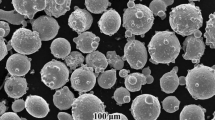Abstract
The ultra-high strength steel AerMet100 was fabricated by laser melting deposition (LMD) process. The effect of hot isostatic pressing (HIP) on high-cycle fatigue properties of the LMD AerMet100 steel was investigated, and the influence of defects on fatigue behavior was discussed. Results showed that the LMD AerMet100 steel had fine directionally solidified cellular-dendrite structure and coarse columnar prior austenite grains. Metallurgical defects such as gas pore and lack-of-fusion porosity were produced during the laser deposition process. After HIP treatment, the number and size of metallurgical ddects had remarkably decreased. Moreover, high-cycle fatigue properties of the alloys after HIP treatment were superior to the as-deposited alloys.
Similar content being viewed by others
References
JI Guo-liang, LI Fu-guo, LI Qing-hua, et al. A Comparative Study on Arrhenius-Type Constitutive Model and Artificial Neural Network Model to Predict High-Temperature Deformation Behaviour in AerMet100 Steel [J]. Materials Science and Engineering, 2011, 528A(13/14): 4774.
Wang Y D, Tang H B, Fang Y L, et al. Microstructure and Mechanical Properties of Laser Melting Deposited 1Cr12Ni2WMoVNb Steel [J]. Materials Science and Engineering, 2010, 527A(18/19): 4804.
Li J, Wang H M. Microstructure and Mechanical Properties of Rapid Directionally Solidified Ni-Base Superalloy Rene’ 41 by Laser Melting Deposition Manufacturing [J]. Materials Science and Engineering, 2010, 527A(18/19): 4823.
Theriault A, Xue L, Dryden J R. Fatigue Behavior of Laser Consolidated IN-625 at Room and Elevated Temperatures [J]. Materials Science and Engineering, 2009, 516A(1/2): 217.
RAN Xian-zhe, CHENG Hao, TANG Hai-bo, et al. Corrosion Properties of Laser Melting-Deposited Corrosion-Resistant Ultrahigh Strength Steel AerMet100 [J]. Transactions of Materials and Heat Treatment, 2012, 33(12): 126 (in Chinese).
YAN Min, ZHANG Shu-quan, WANG Hua-ming. Solidification Microstructure and Mechanical Properties of Corrosion-Resistant Ultra-high Strcngth Steel AerMet100 Fabricated by Laser Melting Deposition [J]. Acta Metallurgica Sinica, 2007, 43(5): 472 (in Chinese).
WANG Yang, WANG Yuan, ZHANG Shu-quan, et al. Solidification Microstructure and High Temperrtture Structured Strtbility of Laser Deposited Ultrahigh Strength Steel AerMet100 [J]. Heat Treatment of Metals, 2011, 36(3): 60 (in Chinese).
He R J, Wang H M. Fatigue Crack Nucleation and Growth Behaviors of Laser Melting Deposited Ti-6Al-2Zr-Mo-V [J]. Materials Science and Engineering, 2010, 527A(7/8): 1933.
Ghosh A. Segregation in Cast Products [J]. Sadhana, 2001, 26(1/2): 5.
ZHANG Feng-ying, CHEN Jing, TAN Hua, et al. Research on Forming Mechanism of Defects in Laser Rapid Formed Titanium Alloy [J]. Rare Metal Materials and Engineering, 2007, 36(2): 211 (in Chinese).
Kobryn P A, Moore E H, Semiatin S L. The Effect of Laser Power and Traverse Speed on Microstructure, Porosity, and Build Height in Laser-Deposited Ti-6Al-4V [J]. Scripta Materialia, 2000, 43(4): 299.
ZHAO Zhen-ye. Studying Status on the Secondary Hardening Phenomenon in Ultra-high Strength Steels [J]. Journal of Aeronautical Materials, 2002, 22(4): 46 (in Chinese).
James T Staley Jr, Murat Tiryakioglu, John Campbell. et al. The Effect of Hot Isostatic Pressing (HIP) on the Fatigue Life of A206-T71 Aluminum Castings [J]. Materials Science and Engineering, 2007, 465A(1/2): 136.
Murakami Y, Metal Fatigue: Effects of Small Defects and Nonmetallic Inclusions [M]. Oxford: Elsevier, 2002.
Yang Z G, Zhang J M, Li S X, et al. On the Critical Inclusion Size of High Strength Steels Under Ultra-high Cycle Fatigue [J]. Materials Science and Engineering, 2006, 427A(1/2): 167.
Author information
Authors and Affiliations
Corresponding author
Additional information
Foundation Item: Item Sponsored by State Key Development Program for Basic Research of China (2011CB606305); Cheung Kong Scholars Innovation Research Team Program of Ministry of Education of China (IRT0805)
Rights and permissions
About this article
Cite this article
Cheng, H., Liu, D., Tang, Hb. et al. Effect of Hot Isostatic Pressing on Fatigue Properties of Laser Melting Deposited AerMet100 Steel. J. Iron Steel Res. Int. 20, 79–84 (2013). https://doi.org/10.1016/S1006-706X(13)60200-9
Received:
Published:
Issue Date:
DOI: https://doi.org/10.1016/S1006-706X(13)60200-9




